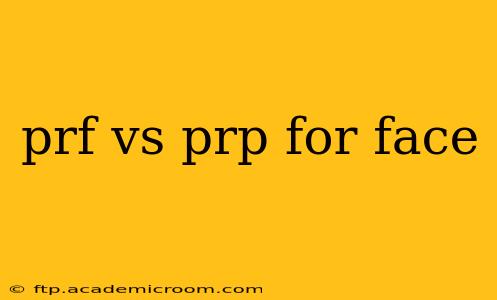Choosing between platelet-rich fibrin (PRF) and platelet-rich plasma (PRP) for facial rejuvenation can feel overwhelming. Both treatments harness the power of your own blood to stimulate collagen production and promote skin regeneration, but they differ in their preparation and potential benefits. This comprehensive guide will dissect the key differences, helping you make an informed decision.
What is PRF?
PRF, or platelet-rich fibrin, is a second-generation centrifugation technique that produces a concentrated fibrin matrix rich in platelets, growth factors, and white blood cells. Unlike PRP, PRF doesn't require any additives like anticoagulants. This natural concentration leads to a more stable clot, resulting in a slower release of growth factors over a longer period. This extended release is believed to contribute to its potential for more sustained rejuvenation effects.
What is PRP?
PRP, or platelet-rich plasma, is a more established treatment that involves drawing a blood sample, centrifuging it to separate the platelet-rich plasma from other blood components, and then injecting it into the treatment area. Often, an anticoagulant like ACD (acid-citrate-dextrose) solution is added to the blood sample before centrifugation. While highly effective, the addition of anticoagulants may slightly alter the properties of the final product compared to PRF.
PRF vs. PRP: Key Differences
| Feature | PRF | PRP |
|---|---|---|
| Preparation | Centrifugation only; no additives | Centrifugation; may use anticoagulants |
| Growth Factor Release | Slower, more sustained release | Faster, shorter release |
| Fibrin Matrix | Strong, stable fibrin matrix | Less prominent fibrin matrix |
| Cost | Generally slightly more expensive | Generally slightly less expensive |
| Treatment Time | Slightly longer | Slightly shorter |
What are the benefits of PRF for the face?
PRF's slower release of growth factors makes it potentially advantageous for:
- Long-term skin rejuvenation: The sustained release promotes collagen production over an extended period, potentially leading to more lasting results.
- Scar treatment: The strong fibrin matrix can help to improve the appearance of scars by promoting tissue regeneration.
- Skin tightening: Enhanced collagen production can contribute to firmer, more youthful-looking skin.
What are the benefits of PRP for the face?
PRP offers several benefits, making it a popular choice:
- Improved skin texture: It can reduce the appearance of wrinkles and fine lines.
- Enhanced skin tone: PRP can improve skin coloration and reduce the appearance of uneven skin tone.
- Faster recovery: The quicker release of growth factors can lead to a faster visible improvement.
Which treatment is right for me?
The ideal treatment depends on individual needs and preferences. Factors to consider include:
- Desired results: If you're seeking long-lasting results, PRF may be preferable. For a quicker improvement, PRP might be a better option.
- Budget: PRF is generally slightly more expensive.
- Medical history: Your doctor will need to review your complete medical history to determine if either treatment is suitable.
How long do the results last?
Both PRF and PRP treatments provide temporary results, with the duration varying from person to person and depending on factors such as age, skin type, lifestyle, and the specific treatment area. While the effects aren't permanent, many patients report noticeable improvement for several months, and repeat treatments can be done to maintain results. The slower release of growth factors in PRF might lead to slightly longer-lasting results, but more clinical research is needed to definitively confirm this.
Are there any side effects?
Side effects are generally minimal and temporary, but can include mild bruising, swelling, and redness at the injection site. These typically resolve within a few days. It is crucial to consult with a qualified medical professional to discuss any potential risks or complications.
What does the recovery process look like?
Recovery time is relatively short for both procedures. Most patients can resume their normal activities immediately, although some mild swelling or bruising may be visible for a few days. Your doctor will provide specific post-procedure instructions.
This information is for general knowledge and should not be considered medical advice. Consult a qualified dermatologist or medical professional to discuss your specific needs and determine the best treatment option for you. They can assess your skin and overall health to recommend the most suitable approach.
